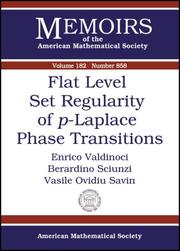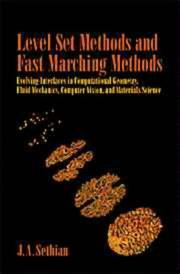| Listing 1 - 5 of 5 |
Sort by
|

ISBN: 0821839101 Year: 2006 Publisher: Providence, R.I. American Mathematical Society
Abstract | Keywords | Export | Availability | Bookmark
 Loading...
Loading...Choose an application
- Reference Manager
- EndNote
- RefWorks (Direct export to RefWorks)
Partial differential equations --- 51 <082.1> --- Mathematics--Series --- Geometry, Differential. --- Laplacian operator. --- Level set methods. --- Ensembles de niveaux, Méthodes d'. --- Laplacien. --- Géométrie différentielle. --- Geometry, Differential --- Laplacian operator --- Level set methods --- Level sets (Mathematics) --- Osher-Sethian level set methods --- Sethian level set methods, Osher --- -Interfaces (Physical sciences) --- Operator, Laplacian --- Differential equations, Partial --- Differential geometry --- Mathematics
Book
ISBN: 3642153518 9786612996320 1282996320 3642153526 Year: 2010 Publisher: Heidelberg : Springer,
Abstract | Keywords | Export | Availability | Bookmark
 Loading...
Loading...Choose an application
- Reference Manager
- EndNote
- RefWorks (Direct export to RefWorks)
Image segmentation consists of dividing an image domain into disjoint regions according to a characterization of the image within or in-between the regions. Therefore, segmenting an image is to divide its domain into relevant components. The efficient solution of the key problems in image segmentation promises to enable a rich array of useful applications. The current major application areas include robotics, medical image analysis, remote sensing, scene understanding, and image database retrieval. The subject of this book is image segmentation by variational methods with a focus on formulations which use closed regular plane curves to define the segmentation regions and on a level set implementation of the corresponding active curve evolution algorithms. Each method is developed from an objective functional which embeds constraints on both the image domain partition of the segmentation and the image data within or in-between the partition regions. The necessary conditions to optimize the objective functional are then derived and solved numerically. The book covers, within the active curve and level set formalism, the basic two-region segmentation methods, multiregion extensions, region merging, image modeling, and motion based segmentation. To treat various important classes of images, modeling investigates several parametric distributions such as the Gaussian, Gamma, Weibull, and Wishart. It also investigates non-parametric models. In motion segmentation, both optical flow and the movement of real three-dimensional objects are studied.
Geometric measure theory. --- Image processing -- Digital techniques -- Mathematics. --- Image segmentation --- Electrical & Computer Engineering --- Engineering & Applied Sciences --- Electrical Engineering --- Telecommunications --- Applied Physics --- Mathematics --- Image processing --- Level set methods. --- Digital techniques. --- Mathematics. --- Level sets (Mathematics) --- Osher-Sethian level set methods --- Sethian level set methods, Osher --- -Digital image processing --- Engineering. --- Image processing. --- Signal, Image and Speech Processing. --- Image Processing and Computer Vision. --- -Interfaces (Physical sciences) --- Digital image processing --- Digital electronics --- Computer vision. --- Machine vision --- Vision, Computer --- Artificial intelligence --- Pattern recognition systems --- Signal processing. --- Speech processing systems. --- Optical data processing. --- Optical computing --- Visual data processing --- Bionics --- Electronic data processing --- Integrated optics --- Photonics --- Computers --- Computational linguistics --- Electronic systems --- Information theory --- Modulation theory --- Oral communication --- Speech --- Telecommunication --- Singing voice synthesizers --- Pictorial data processing --- Picture processing --- Processing, Image --- Imaging systems --- Optical data processing --- Processing, Signal --- Information measurement --- Signal theory (Telecommunication) --- Optical equipment

ISBN: 0521645573 0521642043 9780521642040 9780521645577 Year: 1999 Volume: 3 Publisher: Cambridge : Cambridge University Press,
Abstract | Keywords | Export | Availability | Bookmark
 Loading...
Loading...Choose an application
- Reference Manager
- EndNote
- RefWorks (Direct export to RefWorks)
514.8 --- 681.3*G18 --- 681.3 *G18 Partial differential equations: difference methods elliptic equations finite element methods hyperbolic equations method of lines parabolic equations (Numerical analysis) --- Partial differential equations: difference methods elliptic equations finite element methods hyperbolic equations method of lines parabolic equations (Numerical analysis) --- 514.8 Geometric study of objects of mechanics and physics --- Geometric study of objects of mechanics and physics --- Level set methods --- Level set methods. --- 681.3 *G18 Partial differential equations: difference methods; elliptic equations; finite element methods; hyperbolic equations; method of lines; parabolic equations (Numerical analysis) --- Partial differential equations: difference methods; elliptic equations; finite element methods; hyperbolic equations; method of lines; parabolic equations (Numerical analysis) --- Level sets (Mathematics) --- Osher-Sethian level set methods --- Sethian level set methods, Osher --- -Interfaces (Physical sciences) --- Mathematics --- 681.3 *G18 --- Representation des surfaces

ISBN: 9780387954820 0387954821 9780387227467 1468492519 1280009764 0387227466 9786610009763 Year: 2003 Volume: 153 Publisher: New York : Springer,
Abstract | Keywords | Export | Availability | Bookmark
 Loading...
Loading...Choose an application
- Reference Manager
- EndNote
- RefWorks (Direct export to RefWorks)
This book is an introduction to level set methods and dynamic implicit surfaces. These are powerful techniques for analyzing and computing moving fronts in a variety of different settings. While the book gives many examples of the usefulness of the methods for a diverse set of applications, it also gives complete numerical analysis and recipes, which will enable users to quickly apply the techniques to real problems. The book begins with the description of implicit surfaces and their basic properties, and then devises the level set geometry and calculus toolbox, including the construction of signed distance functions. Part II adds dynamics to this static calculus. Topics include the level set equation itself, Hamilton-Jacobi equations, motion of a surface normal to itself, reinitialization to a signed distance function, extrapolation in the normal direction, the particle level set method, and the motion of codimension two (and higher) objects. Part III is concerned with topics taken from the field of image processing and computer vision. These include the restoration of images degraded by noise and blur, image segmentation with active contours (snakes), and reconstruction of surfaces from unorganized data points. Part IV is dedicated to computational physics. It begins with one-phase compressible fluid dynamics, then two-phase compressible flow involving possibly different equations of state, detonation and deflagration waves, and solid/fluid structure interaction. Next it discusses incompressible fluid dynamics, including a computer graphics simulation of smoke; free surface flows, including a computer graphics simulation of water; and fully two-phase incompressible flow. Additional related topics include incompressible flames with applications to computer graphics and coupling a compressible and incompressible fluid. Finally, heat flow and Stefan problems are discussed. A student or researcher working in mathematics, computer graphics, science, or engineering interested in any dynamic moving front, which might change it's topology or develop singularities, will find this book interesting and useful.
Level set methods. --- Implicit functions. --- Fonctions implicites --- Level set methods --- Implicit functions --- 514.8 --- 681.3*G18 --- Level sets (Mathematics) --- Osher-Sethian level set methods --- Sethian level set methods, Osher --- -Interfaces (Physical sciences) --- Functions, Implicit --- Functions of several real variables --- Geometric study of objects of mechanics and physics --- Partial differential equations: difference methods; elliptic equations; finite element methods; hyperbolic equations; method of lines; parabolic equations (Numerical analysis) --- Mathematics --- Physical Sciences & Mathematics --- Mathematics - General --- Physics --- Atomic Physics --- Mathematical Theory --- 681.3 *G18 Partial differential equations: difference methods; elliptic equations; finite element methods; hyperbolic equations; method of lines; parabolic equations (Numerical analysis) --- 514.8 Geometric study of objects of mechanics and physics --- -Functions, Implicit --- Mathematics. --- Image processing. --- Computer mathematics. --- Continuum physics. --- Mechanics. --- Mechanics, Applied. --- Computational Mathematics and Numerical Analysis. --- Classical Continuum Physics. --- Image Processing and Computer Vision. --- Theoretical and Applied Mechanics. --- 681.3 *G18 --- Computer science --- Computer vision. --- Mechanics, applied. --- Classical and Continuum Physics. --- Optical data processing. --- Applied mechanics --- Engineering, Mechanical --- Engineering mathematics --- Classical mechanics --- Newtonian mechanics --- Dynamics --- Quantum theory --- Optical computing --- Visual data processing --- Bionics --- Electronic data processing --- Integrated optics --- Photonics --- Computers --- Classical field theory --- Continuum physics --- Continuum mechanics --- Computer mathematics --- Optical equipment --- Méthodes d'ensembles de niveaux --- Representation des surfaces --- Méthodes d'ensembles de niveaux
Book
ISBN: 3031086589 3031086597 Year: 2022 Publisher: Cham : Springer International Publishing : Imprint: Springer,
Abstract | Keywords | Export | Availability | Bookmark
 Loading...
Loading...Choose an application
- Reference Manager
- EndNote
- RefWorks (Direct export to RefWorks)
This monograph is devoted to the study of Eulerian models for fluid-structure interaction from the original point of view of level set methods. In the last 15 years, Eulerian models have become popular tools for studying fluid-structure interaction problems. One major advantage compared to more conventional methods such as ALE methods is that they allow the use of a single grid and a single discretization method for the different media. Level set methods in addition provide a general framework to follow the fluid-solid interfaces, to represent the elastic stresses of solids, and to model the contact forces between solids. This book offers a combination of mathematical modeling, aspects of numerical analysis, elementary codes and numerical illustrations, providing the reader with insights into the applications and performance of these models. Assuming background at the level of a Master’s degree, Level Set Methods for Fluid-Structure Interaction provides researchers in the fields of numerical analysis of PDEs, theoretical and computational mechanics with a basic reference on the topic. Its pedagogical style and organization make it particularly suitable for graduate students and young researchers.
Fluid-structure interaction. --- Level set methods. --- Level sets (Mathematics) --- Osher-Sethian level set methods --- Sethian level set methods, Osher --- -Interfaces (Physical sciences) --- Structure-fluid interaction --- Fluid dynamics --- Structural dynamics --- Mathematics --- Models matemàtics --- Mecànica dels medis continus --- Anàlisi numèrica --- Mètodes numèrics --- Algorismes --- Anàlisi matemàtica --- Teoria de l'aproximació --- Anàlisi d'error (Matemàtica) --- Anàlisi d'intervals (Matemàtica) --- Càlculs numèrics --- Equacions diferencials estocàstiques --- Integració numèrica --- Interpolació (Matemàtica) --- Mètodes de Galerkin --- Mètode de Montecarlo --- Mètode dels elements finits --- Mètodes iteratius (Matemàtica) --- Nomografia (Matemàtica) --- Rutes aleatòries (Matemàtica) --- Solucions numèriques --- Mecànica contínua --- Mecànica del continu --- Elasticitat --- Mecànica analítica --- Acústica --- Mecànica de fluids --- Sòlids elàstics --- Termoelasticitat --- Viscoelasticitat --- Teoria de camps (Física) --- Models (Matemàtica) --- Models experimentals --- Models teòrics --- Mètodes de simulació --- Anàlisi de sistemes --- Modelització multiescala --- Models economètrics --- Models lineals (Estadística) --- Models multinivell (Estadística) --- Models no lineals (Estadística) --- Programació (Ordinadors) --- Simulació per ordinador --- Teoria de màquines --- Models biològics --- Mathematical models. --- Continuum mechanics. --- Numerical analysis. --- Mathematical Modeling and Industrial Mathematics. --- Continuum Mechanics. --- Numerical Analysis. --- Computational Science and Engineering. --- Data processing. --- Mathematical analysis --- Mechanics of continua --- Elasticity --- Mechanics, Analytic --- Field theory (Physics) --- Models, Mathematical --- Simulation methods
| Listing 1 - 5 of 5 |
Sort by
|

 Search
Search Feedback
Feedback About UniCat
About UniCat  Help
Help News
News